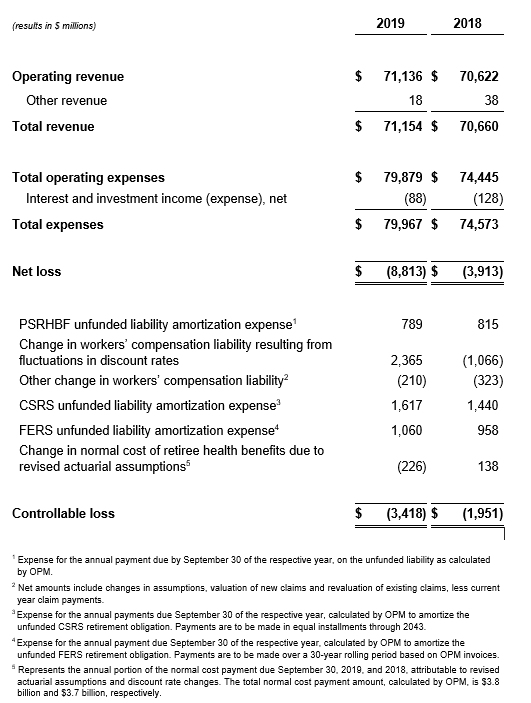WASHINGTON - The U.S. Postal Service reported operating revenue of $71.1 billion for fiscal year 2019 (October 1, 2018 - September 30, 2019), an increase of $514 million compared to the prior year. The higher revenues were driven largely by price increases and continued growth in the Shipping and Packages business, where revenue increased $1.3 billion, or 6.1 percent, which more than offset revenue declines in First-Class and Marketing Mail as a result of declining volumes in that segment of its business.
The total volume of mail and packages delivered during the year declined by 3.8 billion pieces or 2.6 percent, driven largely by First-Class Mail declines of 1.8 billion pieces, or 3.1 percent, and Marketing Mail declines of 1.6 billion pieces, or 2.1 percent. Package volume grew slightly at 16 million pieces, or 0.3 percent, continuing a multi-year trend of declining mail volumes and increasing package volumes, although package volume growth slowed considerably during the year.
“We continue to adjust to declining mail volume and remain focused on leveraging our unique and unrivaled network to gain new customers and grow profitable revenue in the increasingly competitive package business,” said Postmaster General and CEO Megan J. Brennan.
"However, revenue growth in our package business will never be enough to offset imbalances in the Postal Service's business model, which must be addressed through legislative and regulatory reforms in order to secure a sustainable future," Brennan emphasized.
Operating expenses for the year were $79.9 billion, an increase of $5.4 billion, or 7.3 percent, compared to the prior year. This was driven by an increase in workers compensation expense of $3.5 billion, of which $3.4 billion was directly the result of changes in discount rates outside of management's control.
Compensation and benefits expenses increased by $994 million due to contractual wage increases, and retirement benefits expenses increased by $320 million due largely to the higher amortization costs of unfunded benefits. Transportation expenses increased by $323 million as the Postal Service continued to experience increases in fuel prices and highway contract rates.
As planned, the Postal Service reduced its debt level during 2019 by $2.2 billion, finishing the year with $11.0 billion in debt outstanding. This reduction allows the Postal Service to continue to reduce interest costs.
Controllable loss for the year was $3.4 billion, an increase of $1.5 billion compared to the prior year. The net loss for the year was $8.8 billion, an increase in net loss of $4.9 billion compared to 2018. Approximately $3.4 billion of this increase in net loss was the non-cash impact of discount rate changes on actuarial calculations affecting workers' compensation expense.
"We continued to make progress in the fiscal year in containing expenses that are under management’s control,” said Chief Financial Officer and Executive Vice President Joseph Corbett. “However, actions within the control of the Postal Service are not enough to return the Postal Service to financial health."
FY 2019 Operating Revenue and Volume by Service Category Compared to Prior Year
The following presents revenue and volume by service category for the year ended September 30, 2019, and 2018:

Selected FY 2019 and 2018 Results of Operations and Controllable Loss
This news release references controllable loss, which is not calculated and presented in accordance with accounting principles generally accepted in the United States (GAAP). Controllable loss is defined as net loss adjusted for items outside of management’s control and non-recurring items. These adjustments include workers’ compensation expenses caused by actuarial revaluation and discount rate changes, and the amortization of PSRHBF, CSRS and FERS unfunded liabilities. The following table presents selected results of operations and reconciles GAAP net loss to controllable loss and illustrates the loss from ongoing business activities without the impact of non-controllable items for the twelve months ended September 30, 2019, and 2018:

Complete financial results are available in the Form 10-K, available at http://about.usps.com/who-we-are/financials/welcome.htm.


